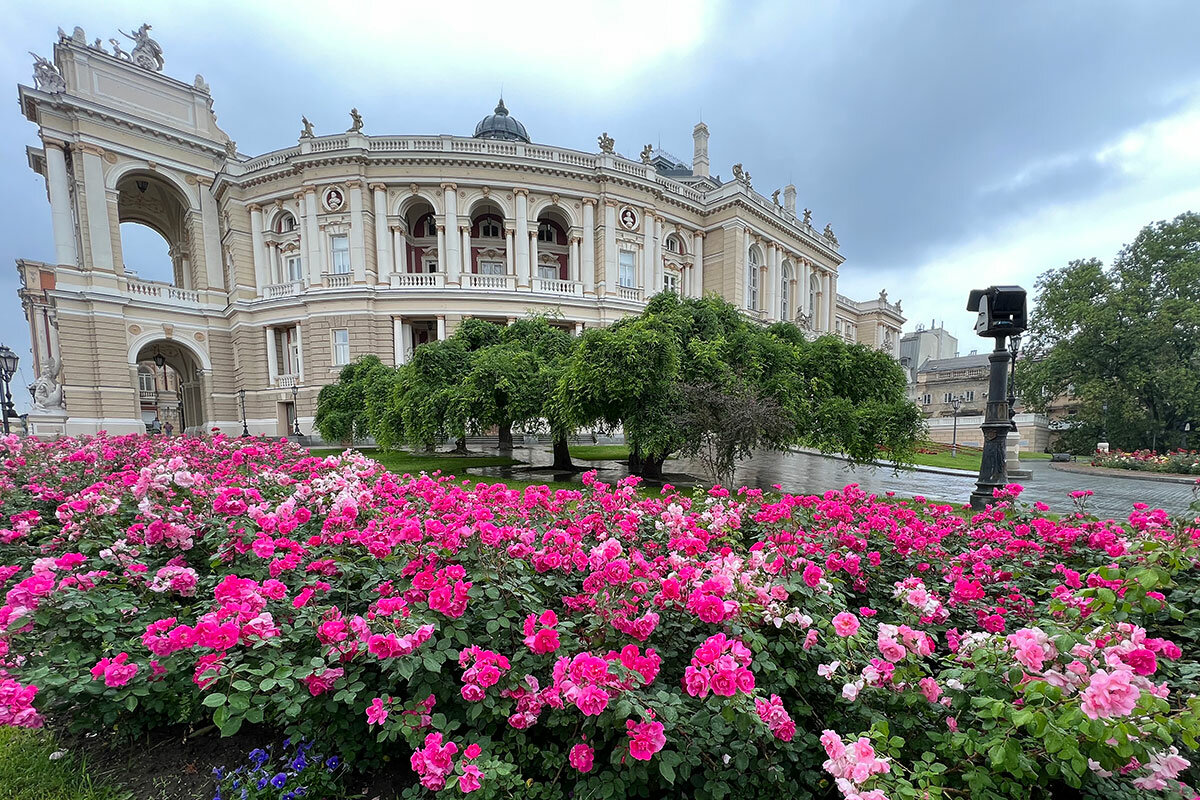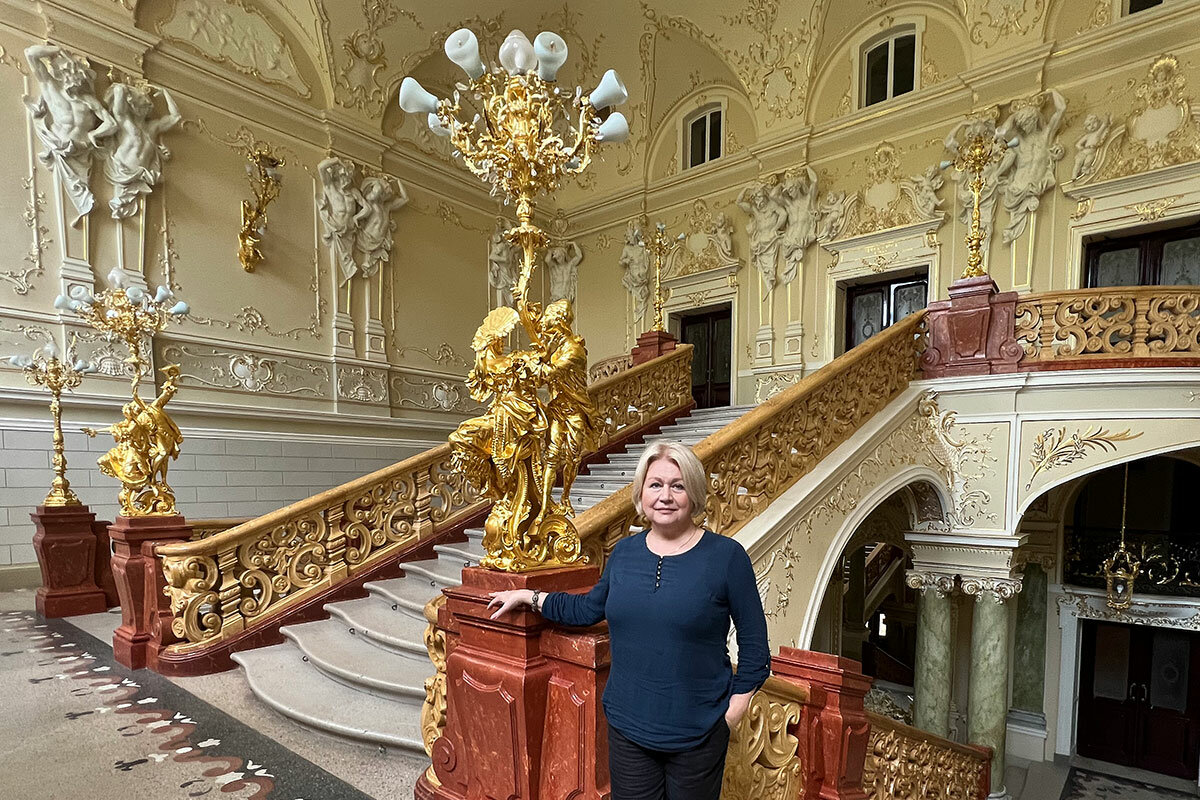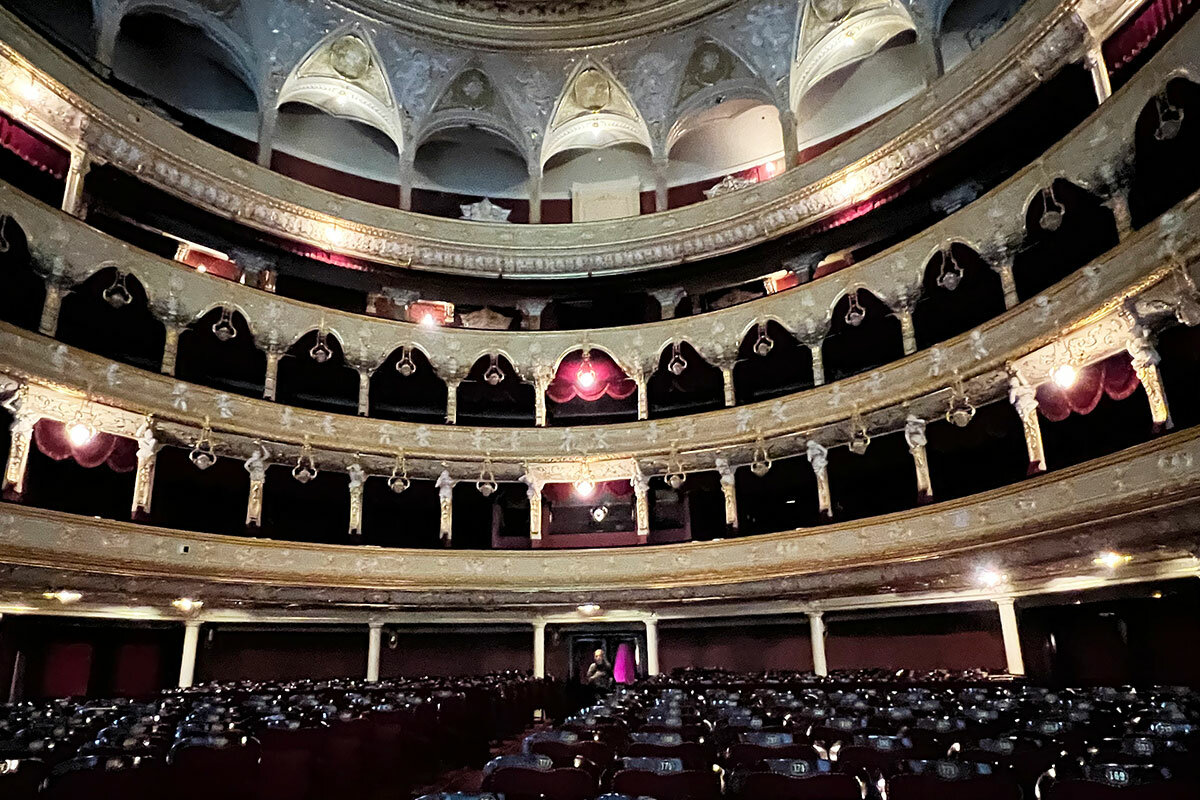Now playing at Odesa’s opera house: Renewal and hope
Loading...
| ODESA, Ukraine
Everyone is here.
Overnight strikes by Russian missiles and attack drones on the Black Sea port city of Odesa have just killed three people, wounded others, destroyed apartments and businesses, and forced the closure of major traffic arteries.
But this very next morning, at the jewel box of an opera house in the city’s historic center, dancers, musicians, choreographers, set designers, stagehands, and youth dance instructors and their diminutive charges – all are present for a full day of rehearsals for the children’s ballet “Thumbelina,” which is set to open in 48 hours.
Why We Wrote This
A story focused onFor most people, how relevant an art form is opera? In the Ukrainian Black Sea port of Odesa, a community living under the clouds of war, what has been dismissed as elitist elsewhere has emerged as a pillar of strength and support.
It’s been this way at the Odesa Opera – officially, the Odesa National Academic Opera and Ballet Theatre – since shortly after Russia’s full-scale invasion of Ukraine in February 2022. Since then, the opera house – though in so many places the art form is dismissed as an elitist art form with little relevance to today’s challenges and mindsets – has emerged as an immanent pole of strength, support, and solace for a city living under the clouds of war and aggression.
“We try to be as strong and resilient as we can, not just for ourselves, but as a support for Odesa and all of Ukraine,” says Liudmyla Serhiychuk, public relations assistant to the Odesa Opera’s general director. “You see that despite a night of explosions, everyone is on hand for rehearsals.”
The opera house, built in the Vienna baroque style in 1887, has long been known as the “pearl of Odesa.” But over recent years, the opera and ballet companies housed in it have become much more.
“We are more than this beautiful building; we are the heart of our city,” Ms. Serhiychuk says. “And when the people see this heart is beating, this gives them hope.”
That conviction about a cultural institution’s role in feeding a besieged city’s soul is what led a shuttered opera to defiantly reopen on March 12, 2022 – just over two weeks after Russia launched its invasion.
Attendance at the initial wartime performances was limited to the 450 patrons who could be accommodated in the building’s bomb shelter. (Since then, shelter space has been expanded so that now an audience of over 1,100 can be accommodated.)
Perhaps more important, the opera opened its doors to Ukrainians most affected by the war and took its works – and its beating heart – outside its walls.
Dancers performed on the square outside the building, opera and ballet employees marched to protest Russia’s aggression, military families and Ukrainians displaced by the war were offered free admission to events, and singers and dancers performed at military camps.
To mark Ukraine’s Independence Day last August, singers offered a program of arias and patriotic anthems on the opera’s fountain-splashed plaza that left many in the audience of several hundred in tears.
“We’ve even done flash mobs around the city,” says Harry Sevoyan, the Odesa ballet’s chief choreographer. “We are constantly looking for ways to take what we do outside these walls to the world of everyday living.”
What makes that outreach especially important now is that Odesans’ “everyday living” is marked by war.
“All of the fighting, the bombings and explosions, and the constant uncertainty can be depressing,” adds musical director Volodymyr Vrublevsky. “Cultural events can be such an important antidote,” he says, “so we at the opera have made it a priority to go out and help keep the people’s spirits up.”
The decision to produce a ballet based on the Hans Christian Andersen fairy tale “Thumbelina” was motivated by a desire to reach out to Odesa’s children with something beautiful, action-filled, and ultimately happy.
“This is a show about hope and courage, and in the end, good things happening,” says Mr. Vrublevsky.
For Mr. Sevoyan, creating a show based on Andersen’s tale of a tiny girl who faces many challenges in a number of threatening worlds before finding a happy home seemed just right for Ukraine’s children at this moment.
“It’s the story of going through dark times as we are in Ukraine but ending up in a safe and beautiful place,” he says. “We wanted to tell the children, ‘Hope is coming back!’”
And it was important to make the show – despite its fantastic worlds with sometimes sweet, sometimes aggressive and frightening animal characters – a reflection of Ukraine.
For that, the producers turned to senior costume and set designer Anna Ipatieva. Under her guidance, the tulip that Thumbelina is traditionally born in became a cotton flower, and costumes included more of the yellow and sky blue of the Ukrainian flag. A large teardrop that reigns over a number of scenes became a drop of morning dew, “so instead of sadness we have a symbol of renewal and hope,” she says.
Most important for Ms. Ipatieva was the use of a large map of Ukraine – unabashedly including the Crimean Peninsula and the areas of southeastern Ukraine that Russia now occupies – as a dominant backdrop in the show’s final scenes.
“When Thumbelina is stolen by the mole creatures, the map turns red. It’s the equivalent of our air raid sirens and the fires of the Russian aggression,” she says.
But by the final scene, when Thumbelina is delivered to her happy home by elves with angel wings – those angels representing the fallen heroes of Ukraine’s fight for freedom, Ms. Ipatieva says – the map has turned yellow and blue.
“My point is not for children to come to the show to see war, but to use a context of war like the one we are experiencing to reassure the children that Ukraine is our home of hope and happiness,” she says.
As the audience for the pre-premiere dress rehearsal for “Thumbelina” pours out into the Odesa sunshine on a recent afternoon, it is unclear how much of an impression the show’s symbolism and messaging made on the children in attendance.
A group of boys from a Thai boxing class attending the show with their coach are all thumbs-up. They liked the jumping and leaping and fighting scenes best.
“I’m not sure how much they grasped of the references to our situation today. I’m not sure I got it all myself,” says coach Sarhis Kratchatrian. “But what did come through from the show is that Ukraine will go on and hope will prevail,” he adds. “And I think in some ways [the boys] felt that.”
With the war becoming the government’s top priority, the Odesa Opera has lost its national subsidies. The institution is more dependent on ticket sales, and to replace lost funding, the widely acclaimed opera and ballet companies have multiplied the number of revenue-generating shows they perform in European cities.
A quest for deep-pocketed patrons and sponsors goes on.
But no lack of funding is going to dim the opera’s enthusiasm for serving its city and buoying spirits, says Ms. Serhiychuk, the public relations assistant.
“There’s the old saying in the performing arts: ‘The show must go on,’” she says. “Now that saying means something very different and very important for us. We see the opera as the front line for our city in this period of war,” she adds. “We must go on to keep the heart beating and give people hope.”
Oleksandr Naselenko supported reporting for this story.










